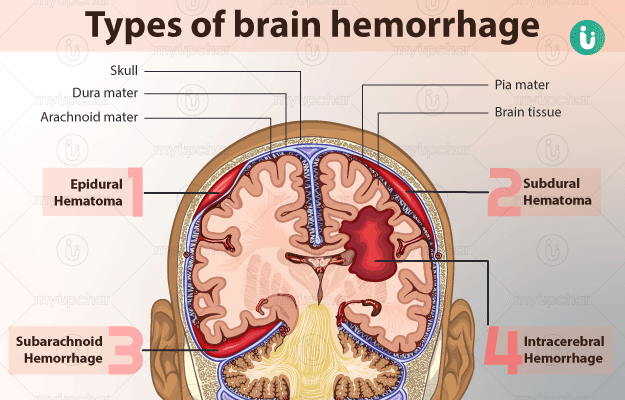What is brain haemorrhage?
Brain haemorrhage is a condition characterised by bleeding that occurs in and around the brain mainly caused due to bursting of a blood vessel in the brain. It is also called brain bleed.
Brain haemorrhage can increase the pressure in the brain, reduce the oxygen level and thus kill brain cells. Symptoms of brain haemorrhage require immediate medical attention.
Depending upon the site, there are four types of brain haemorrhages:
- Epidural haemorrhage
- Subdural haemorrhage
- Subarachnoid haemorrhage
- Intracerebral haemorrhage
What are its main signs and symptoms?
When there is bleeding within the brain, there is no headache since brain cells cannot register the disturbance. However, when the bleeding is within the meninges (the coverings of brain), severe headache is the most common symptom.
Other symptoms include
- Weakness or tingling or numbness (on one side)
- Speech disturbance
- Loss of balance
- Impaired vision
- Loss of consciousness
- Seizures
What are its main causes?
Brain haemorrhage may occur due to many reasons:
- Trauma or injury to the brain
- Weakening or rupture of a cerebral artery
- Bleeding disorders like platelet deficiency
- Liver diseases like cirrhosis
- High blood pressure
- Brain tumour
Increased blood pressure is the most common cause of brain haemorrhage. It damages the cerebral vessels leading to accumulation of blood which leads to stroke. It accounts for 13% of strokes.
When blood due to injury irritates the tissues, it causes swelling. This is called cerebral oedema. The pooled blood forms a haematoma which increases the pressure on the nearby brain tissue and reduces oxygen supply to the brain cells. This, in turn, leads to death of brain cells.
How is it diagnosed and treated?
On the basis of the symptoms, the doctor may ask for an MRI or CT scan to locate the site of haemorrhage. Other tests include:
- Angiogram- a dye is inserted in the brain artery to look for the exact site of leakage
- Computed tomography angiography
- Cerebrospinal fluid examination
- Lumbar puncture
Close monitoring of the patient is crucial in the initial few hours till the condition completely stabilizes. Stabilization of blood pressure and breathing is the first step, closely followed by the decision to perform surgery, if needed.
A BrainPath surgery is a novel method and causes less scarring and rapid recovery as compared to traditional surgery.
The blood surrounding the brain is drained out to relieve the pressure.
Medicines are used to control blood pressure, seizures and headaches. Correcting the underlying cause is important while managing symptoms of a haemorrhage.
Response to treatment varies depending upon the extent and site of haemorrhage.
Sometimes, death may occur in spite of prompt medical attention.
Overall, the prognosis is not specific. Many patients survive well, while some do not if the bleeding is in certain areas of the brain or is massive. Some may survive with persistent or prolonged weakness, sensory problems, seizures, headaches or memory problems.

 OTC Medicines for Brain Hemorrhage
OTC Medicines for Brain Hemorrhage















